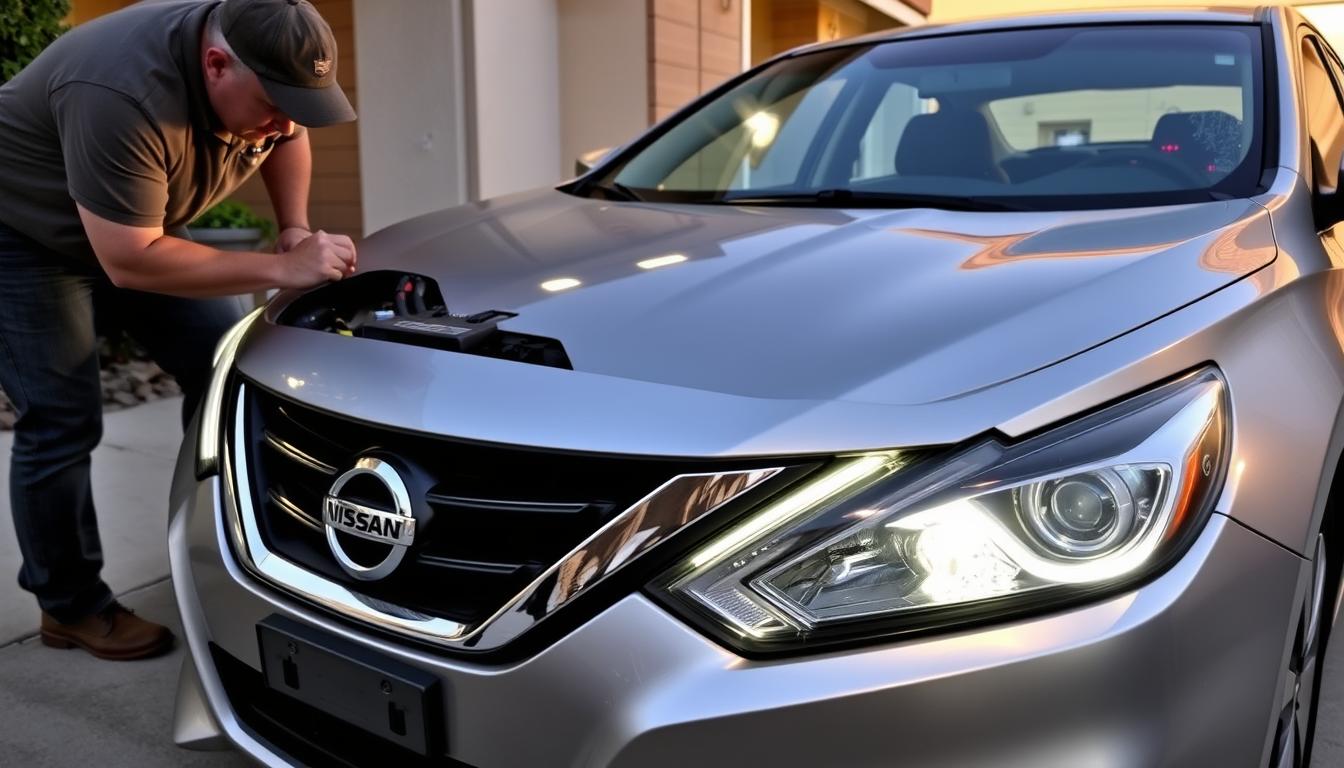If you own a Nissan Altima, knowing the signs of a dead battery is key. Look out for dim or flickering lights, trouble starting the engine, and clicking sounds. Spotting these signs early can save you a lot of hassle.
It’s important to know the signs of a dead battery in your Nissan Altima. This can help keep your car running smoothly. Dead batteries can be caused by many things, like old batteries, corrosion, or extreme weather. By watching for these signs, you can prevent battery problems.
Key Takeaways
- Recognize the signs of a dead battery in your Nissan Altima, such as dim or flickering lights and difficulty starting the engine.
- Understand that Nissan Altima dead battery symptoms can be caused by worn-out batteries, corrosion, or extreme temperatures.
- Regular maintenance can help prevent battery issues in your Nissan Altima.
- Local Nissan dealers’ technicians can perform accurate battery load tests to determine if the battery is still within proper performance specs.
- Avoiding extended periods of inactivity and turning off electrical components when parking can help prolong battery life.
- Checking battery date codes and terminals for corrosion can help identify potential battery issues.
Common Nissan Altima Dead Battery Symptoms
It’s important to know the Altima battery failure signs to avoid sudden breakdowns. Spotting these symptoms early can help fix problems before they get worse.
Slow Engine Cranking
If your Nissan’s engine starts slowly, it might be a sign of a dead battery. This slow start means the battery can’t give enough power to start the engine right away.
Clicking Sounds When Starting
When you hear clicking sounds trying to start your Altima, it’s a clear warning. It means the battery can’t give enough energy to the starter motor. This clicking is often one of the first Altima battery failure signs.
Dimming Headlights
Dim or flickering headlights when starting the car can also indicate a dead battery. A weak battery can’t keep the lights bright, affecting your car’s lighting.
Understanding Your Altima’s Battery System
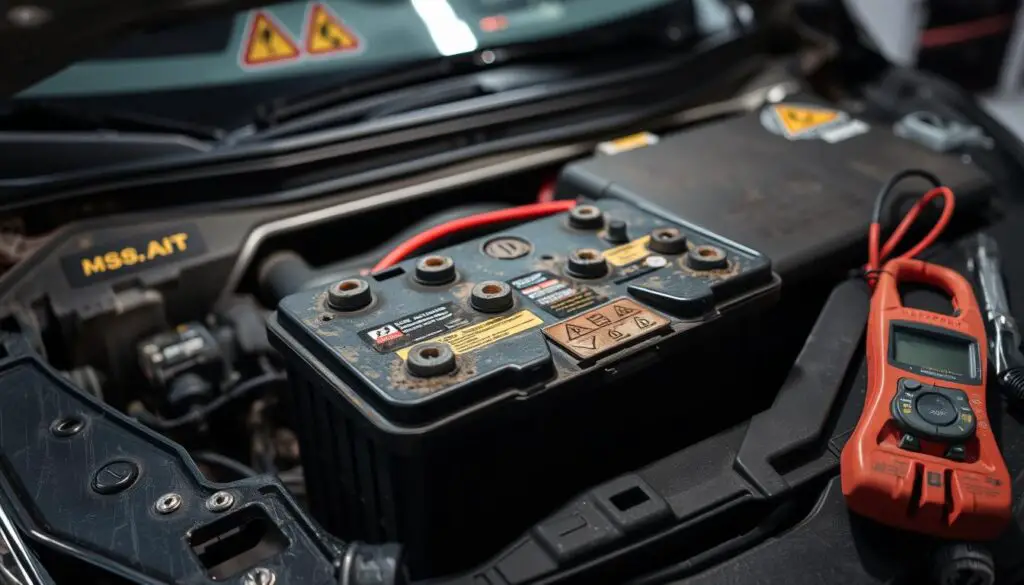
The Nissan Altima needs its battery to start the engine and power electrical parts. To know if your Altima’s battery is dead, you should understand its role and signs of trouble.
The battery and alternator work together for your car to run well. The alternator charges the battery, while the battery gives power to start the engine and run accessories like lights and the radio.
- Starting the Engine: The battery gives a burst of power to start the engine.
- Powering Electrical Components: It powers everything from headlights to dashboard instruments.
- Storing Energy: It stores energy from the alternator for later use.
An Altima battery usually lasts three to five years. But, Altima battery issues can happen due to extreme temperatures and how you drive. Cold weather makes the battery less efficient, while heat speeds up wear. Also, short trips can stop the battery from fully charging, making it less effective over time.
| Factor | Impact on Battery |
|---|---|
| Temperature Extremes | Cold can slow chemical reactions; heat accelerates wear |
| Driving Habits | Short trips may not fully charge the battery |
| Electrical Loads | High usage can drain the battery faster |
| Battery Maintenance | Regular checks can extend battery life |
Dashboard Warning Lights and Their Meanings
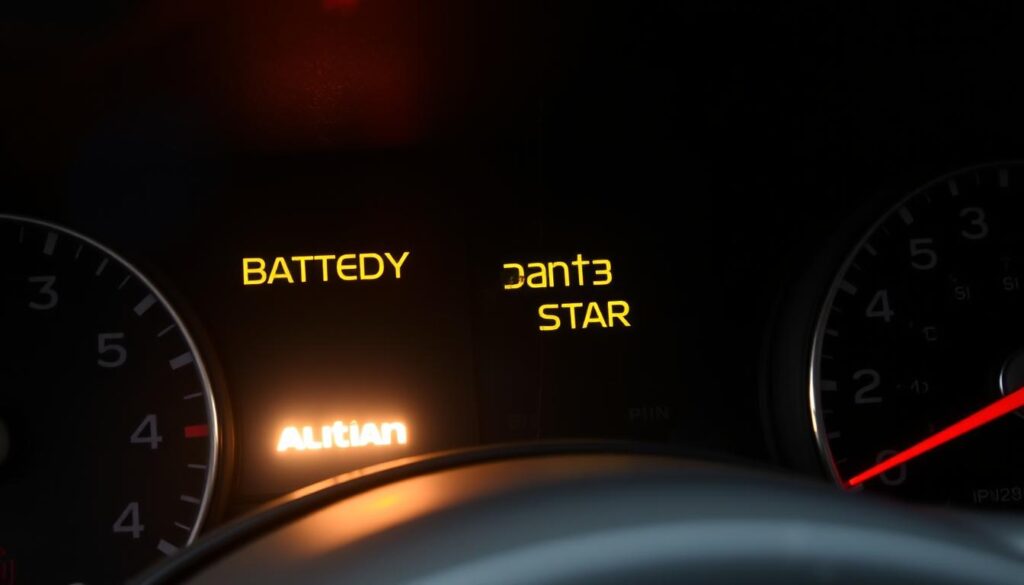
Your Nissan Altima’s dashboard has warning lights for potential issues. These include signs of a dead battery in Nissan Altima. Spotting these signs early can stop unexpected breakdowns.
Battery Warning Light
The battery warning light turns on when there’s a problem with the charging system. This might be because the alternator is failing or the battery is weakening. If you see this light, check the battery charge and connections right away.
Check Engine Light
A common Nissan Altima dead battery symptoms is the check engine light coming on. This light can mean many things, but a dead battery can cause it to turn on. It happens when the battery’s voltage drops, affecting the engine’s performance.
Electronic System Warnings
Other electronic system warnings, like malfunctioning sensors or issues with infotainment systems, might mean the battery isn’t working right. These problems often happen when the battery can’t power all the electronic parts.
| Warning Light | Meaning | Recommended Action |
|---|---|---|
| Battery Icon | Charging system issue or battery problem | Inspect battery and alternator connections; seek professional help if needed |
| Check Engine | Possible engine performance issues related to battery | Check battery voltage and engine components; consult a mechanic |
| Electronic System Alert | Insufficient power to electronic components | Test battery health and ensure all connections are secure |
Electrical Component Malfunctions
Aging batteries can mess up many electrical systems in your Nissan Altima. When a Nissan car battery dies, you might see several Altima battery failure signs. These signs can really affect how you use your car every day.
- Power Windows: Sluggish or non-responsive windows show a power problem.
- Central Locking: Trouble locking or unlocking doors points to a weak battery.
- Infotainment Systems: Odd glitches or shutdowns in audio and navigation.
- Climate Control: Unstable temperature or slow response from the HVAC system.
These problems often start off and then get worse if not fixed quickly. Not paying attention to these Altima battery failure signs can cause bigger electrical issues. This could make repairs much more expensive. It’s key to keep your battery in check and do regular maintenance to keep everything running right.
How Weather Affects Your Altima’s Battery Life
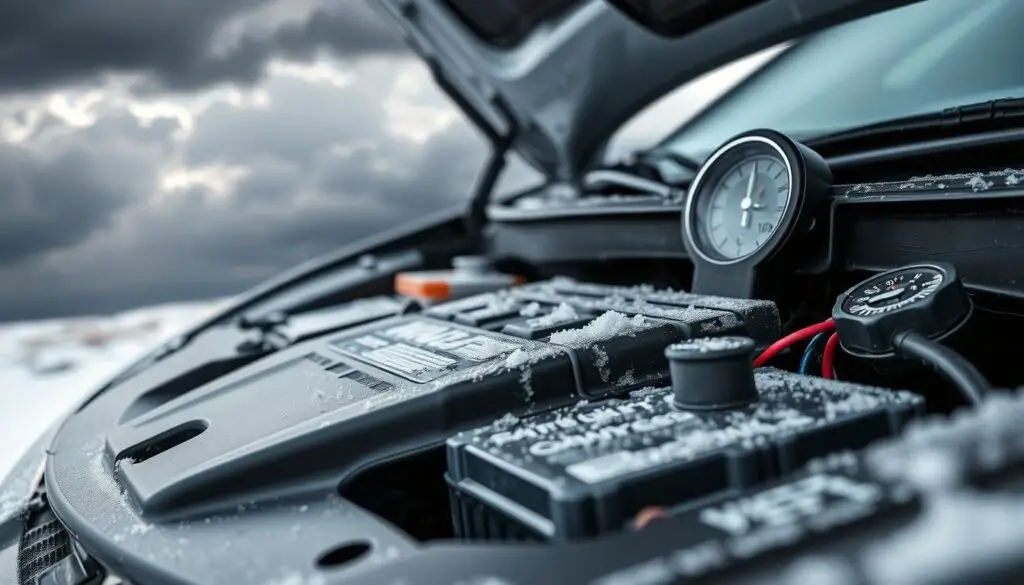
Extreme temperatures can really affect your Altima battery. They can change how well it works and how long it lasts. Knowing this helps you deal with Altima battery issues better.
Cold Weather Impact
In cold places, the battery’s chemical reactions slow down. This makes it harder for your Nissan Altima to start. It’s a sign that your how to know Nissan Altima battery is dead.
Hot Weather Challenges
When it’s hot, the battery loses fluid faster. This damages it inside and shortens its life. Heat also makes the battery work harder, leading to Altima battery issues.
Seasonal Battery Care
- Park in shaded or garage areas to protect the battery from extreme temperatures.
- Use battery insulators during winter to retain heat and improve performance.
- Regularly inspect battery terminals for corrosion, before summer months.
| Weather Condition | Impact on Battery Lifespan | Maintenance Tips |
|---|---|---|
| Cold | Reduces battery efficiency and starting power | Use battery warmers and keep the car in a garage |
| Hot | Speeds up fluid evaporation and deteriorates internal components | Park in shaded areas and regularly check battery health |
| Moderate | Optimal conditions for battery performance | Maintain regular inspection and cleaning schedules |
Using a Multimeter to Test Battery Health
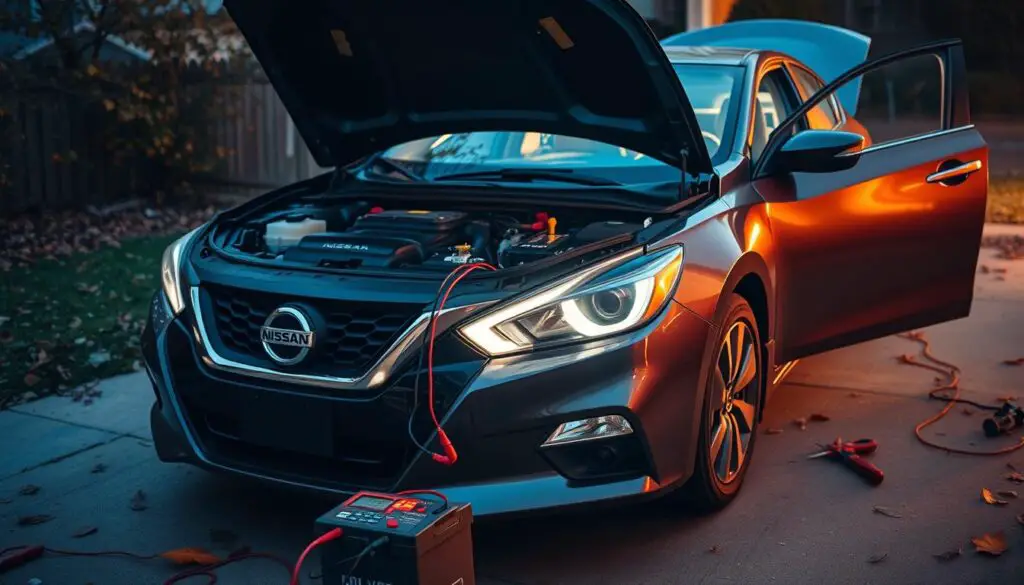
Detecting Nissan Altima dead battery symptoms early can save time and money. A multimeter is a handy tool for checking your Altima battery’s condition.
- Turn off your vehicle and all accessories.
- Set the multimeter to measure voltage (V).
- Connect the red probe to the positive (+) terminal and the black probe to the negative (-) terminal of the battery.
- Read the voltage display:
- 12.4V to 12.8V: Fully charged.
- 12.2V to 12.4V: Good condition with slight discharge.
- 12.0V to 12.2V: Partially discharged.
- Below 12.0V: Poor condition; the battery won’t start reliably.
Always wear protective gear and avoid short circuits when working with your battery. Regularly testing can identify if the battery needs replacement before it leaves you stranded with an Altima battery won’t start situation.
Battery Age and Replacement Timeline
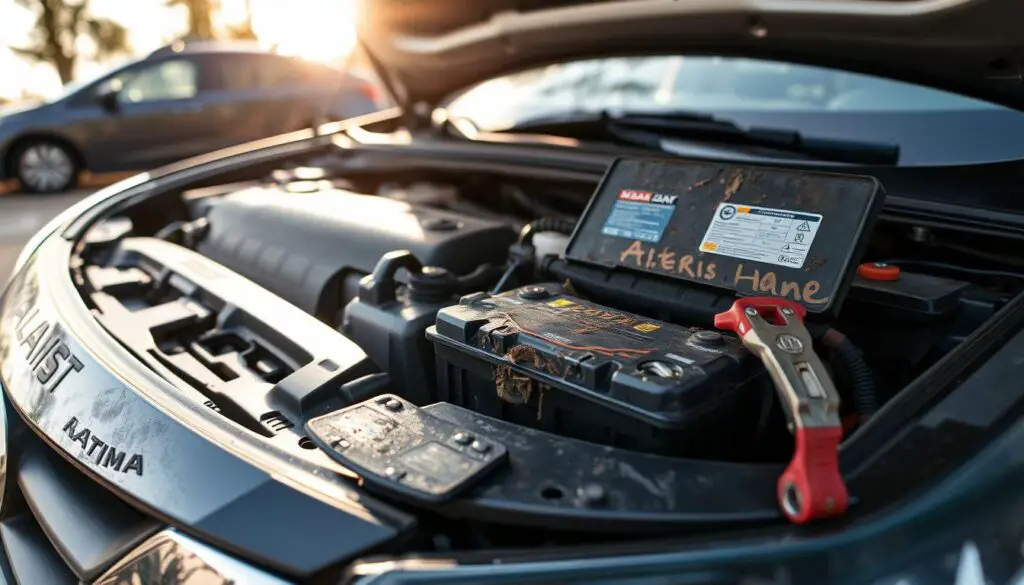
It’s important to keep an eye on your Nissan Altima’s battery age. Even if you don’t see any signs, an old battery might not hold a charge well.
Average Battery Lifespan
Most car batteries, like those in the Nissan Altima, last three to five years. Checking the date code on your battery can tell you its age. As batteries get older, they can’t hold a charge as well, causing problems.
When to Schedule Replacement
It’s smart to replace your battery before it fails completely. Replacing it early can prevent being stuck with a dead car. If your battery is getting old, even if it seems fine, it’s time to get a new one.
| Battery Age | Recommended Actions | Potential Altima Battery Issues |
|---|---|---|
| 0-3 years | Regular maintenance and checks | Minimal issues expected |
| 3-5 years | Begin considering replacement | Possible reduced performance |
| 5+ years | Replace battery proactively | Increased likelihood of failure |
Jump-Starting Your Nissan Altima Safely
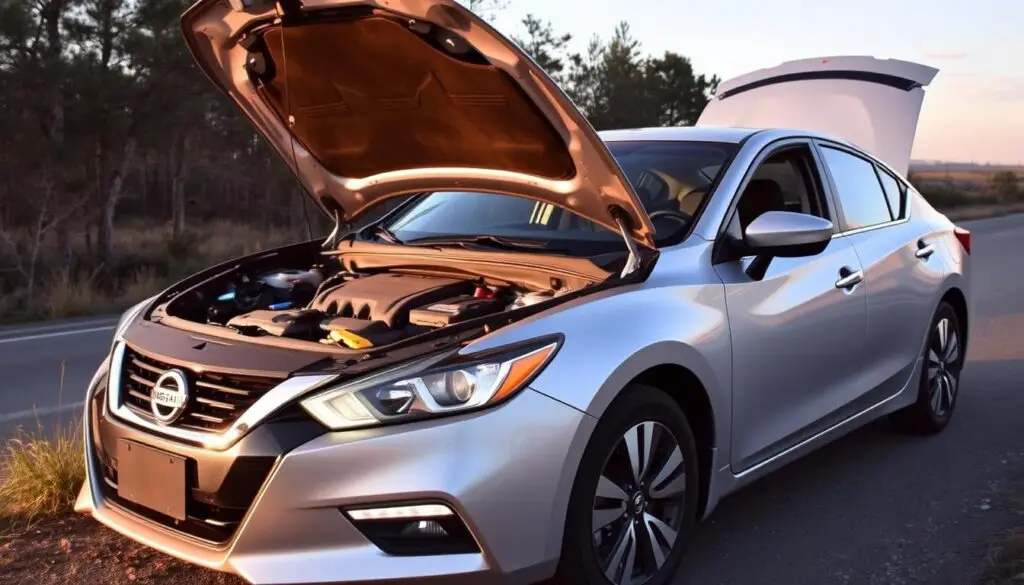
If your Altima battery won’t start, jump-starting can get you back on the road quickly. First, make sure both cars are turned off and parked close enough for the jumper cables to reach.
Attach one red clamp to the positive terminal of the dead battery. Then, connect the other red clamp to the positive terminal of the good battery. Next, attach one black clamp to the negative terminal of the good battery. The other black clamp goes to an unpainted metal surface on your Altima.
Start the working vehicle and let it run for a few minutes. Then, try starting your Nissan. If it starts, let both cars run for a few minutes to ensure the battery charges properly.
Remember, jump-starting should be done carefully to avoid electrical damage. If your Nissan car battery dies frequently, it might be time to replace it or consult a professional for a thorough diagnosis.
| Method | Success Rate | Best Use |
|---|---|---|
| Jump-Starting | 85% | Immediate starts |
| Battery Charger | 75% | Charging over time |
| Battery Replacement | 95% | Old or damaged batteries |
Battery Maintenance Best Practices
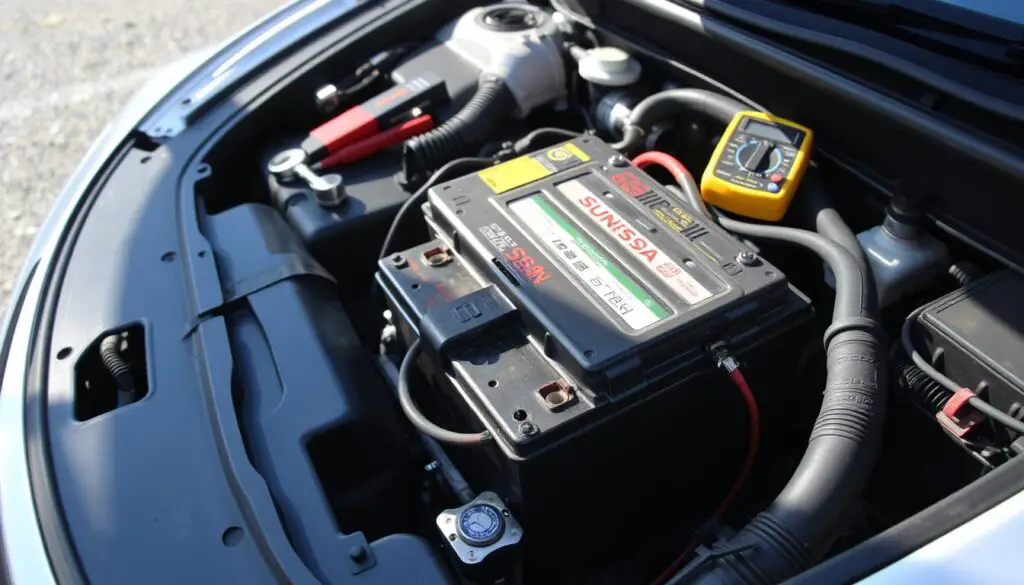
Keeping your Nissan Altima’s battery in good shape is key to avoiding sudden power losses. Knowing how to know Nissan Altima battery is dead can help you avoid trouble.
Regular Cleaning Tips
Make sure to clean the battery terminals to stop corrosion. Mix baking soda and water to clean them gently. Dry the battery before reconnecting to keep it working well.
Connection Checks
Check the battery connections often to make sure they’re tight. Loose connections can cause poor electrical contact, leading to Nissan Altima battery replacement signs.
Professional Inspection Schedule
Get a professional to check your battery at least twice a year or every 6,000 miles. Catching problems early can make your battery last longer and keep your Altima running smoothly.
| Maintenance Task | Recommended Frequency | Additional Tips |
|---|---|---|
| Clean Battery Terminals | Every 6 months | Use a baking soda solution and ensure terminals are dry |
| Check Connection Tightness | Every 3 months | Ensure clamps are secure to prevent electrical issues |
| Professional Battery Inspection | Twice a year or 6,000 miles | Have a certified technician assess battery health |
The Role of the Alternator in Battery Health

The alternator is key to keeping your Nissan Altima’s battery healthy. It charges the battery when the engine is on, powering all electrical parts. If your Nissan car battery dies, check if the alternator is the problem.
Knowing Altima battery failure signs helps spot alternator problems early. Here are some signs to watch for:
- Dim or flickering headlights
- Electrical components malfunctioning
- Battery warning light appearing on the dashboard
If you see these signs, the alternator might be failing, not the battery. A simple voltage test can confirm this. A good battery should read around 12.6V when off and 13.5V to 14.4V when running. If the voltage doesn’t rise with the engine, the alternator could be bad.
It’s important to know these signs because a bad alternator can drain the battery. This can cause your Nissan car battery dies unexpectedly. Regular checks and maintenance can avoid sudden breakdowns and keep your car reliable.
| Component | Normal Voltage | Faulty Voltage | Replacement Cost |
|---|---|---|---|
| Battery (Engine Off) | ~12.6V | Below 12V | $50-$120 |
| Battery (Engine Running) | 13.5V-14.4V | Below 13V | $500-$1000 |
| Voltage Drop (Power Circuit) | ≤0.50V | >0.50V | N/A |
| Voltage Drop (Ground Circuit) | ≤0.25V | >0.25V | N/A |
Common Battery Drainage Causes
Knowing why batteries drain can help stop Altima battery issues. Spotting these problems keeps your Nissan Altima running well.
Interior Lights
Leaving interior lights on can drain your battery fast. Make sure to turn off all lights when parked to prevent Nissan Altima dead battery symptoms.
Parasitic Draws
Devices like alarms, car stereos, or dashcams can draw power even when off. This can lead to Altima battery issues.
Faulty Components
Bad electrical parts, like switches or wiring, can drain power without warning. Regular checks can catch these problems before they cause a dead battery.
| Cause | Symptoms | Prevention Tips |
|---|---|---|
| Interior Lights | Lights remain on after parking | Double-check all lights are off before exiting |
| Parasitic Draws | Frequent dead battery despite regular use | Unplug aftermarket accessories when not in use |
| Faulty Components | Electrical malfunctions, unexplained battery drain | Regularly inspect and maintain electrical systems |
Preventing Future Battery Issues
Keeping your Nissan Altima’s battery in good shape is key to avoiding sudden failures. Good driving habits can help your battery last longer.
- Drive regularly: Make sure to drive your Altima at least once every two days to keep the battery charged.
- Avoid short trips: Short drives don’t give the alternator enough time to fully recharge the battery.
- Limit electrical usage: Try to use fewer electrical accessories when the engine is off to cut down on battery drain.
It’s also important to prepare your battery for times when it won’t be used. If you’re going to leave your Altima unused for a while:
- Disconnect the battery: This stops any battery drain from parasitic draws.
- Use a battery maintainer: This keeps the battery charged during long periods of inactivity.
- Store in a cool, dry place: Extreme temperatures can harm your battery’s performance.
Regular maintenance checks can spot Signs of a dead battery in Nissan Altima early. By following these tips, you can lower the risk of your Altima battery won’t start when you really need it.
| Maintenance Practice | Frequency | Benefits |
|---|---|---|
| Regular Driving | Daily or every other day | Keeps the battery charged and prevents sulfation |
| Battery Inspection | Monthly | Identifies corrosion or loose connections early |
| Use of Battery Maintainer | As needed during long-term storage | Maintains optimal charge without overcharging |
| Clean Battery Terminals | Every 6 months | Ensures good electrical connection and reduces resistance |
Professional vs DIY Battery Replacement
Deciding to replace your Nissan Altima battery yourself or get professional help depends on many factors. Knowing Nissan Altima battery replacement signs can help you make a choice.
Cost Comparison
Choosing between professional and DIY battery replacement means looking at costs. Professional services might cost more at first but offer expertise and tools.
| Aspect | Professional Replacement | DIY Replacement |
|---|---|---|
| Initial Cost | Higher due to labor fees | Lower, only battery and tools needed |
| Warranty | Often includes service warranty | Depends on battery warranty |
| Time Investment | Quick and convenient | Requires time and effort |
| Skill Level | No expertise needed | Basic mechanical skills required |
Warranty Considerations
Professional replacements usually come with warranties for both the battery and installation. When figuring out how to know Nissan Altima battery is dead, having warranty coverage is key. It gives peace of mind and protects against future problems.
Emergency Battery Measures
When your Nissan car battery dies on the road, it’s stressful. Here are steps to help your Altima battery start again.
Portable Jump Starters: A portable jump starter is a good idea. These small devices can start your car without another car’s help. They’re a quick fix when Altima battery won’t start.
Emergency Services: Roadside help programs offer jump-starts and battery replacements. Calling AAA can get you quick, professional help when your Nissan car battery dies.
Stranded in Remote Areas: If you’re in a remote spot, stay safe. Keep an emergency kit with a flashlight, blanket, and snacks in your car. Also, have a car charger for your phone to call for help if Altima battery won’t start.
- Keep a charged portable jump starter in your vehicle.
- Subscribe to a reliable roadside assistance program.
- Maintain an emergency kit with essential supplies.
- Regularly check your battery’s health to prevent unexpected failures.
With these emergency steps, you can handle Nissan car battery dies situations confidently. This way, you can reduce downtime.
Choosing the Right Replacement Battery
Choosing the right battery for your Nissan Altima is key. Knowing the difference between OEM and aftermarket batteries helps keep your Altima running smoothly.
OEM vs Aftermarket Options
OEM batteries are made just for your Altima. They ensure your car works best and often come with a two-year warranty. Aftermarket batteries, like DieHard or Odyssey, might be cheaper but need to match your Altima’s specs to avoid problems.
Battery Specifications
Look at the battery’s Cold Cranking Amps (CCA), reserve capacity, and size. CCA helps start your car in cold weather. Reserve capacity keeps systems running if the alternator fails. Make sure the battery fits your Altima’s tray to avoid installation issues.
| Specification | Recommended Value | Importance |
|---|---|---|
| Cold Cranking Amps (CCA) | 600-650 | Ensures reliable starts in cold weather |
| Reserve Capacity | 90-120 minutes | Keeps essential systems running during alternator failure |
| Battery Size | Group Size 35 | Ensures proper fitment in the battery tray |
| Battery Type | SLI (Starting, Lighting, Ignition) | Matches the Altima’s electrical requirements |
Conclusion
Knowing the signs of a dead battery in your Nissan Altima is key to keeping your car running well. Look out for slow engine starts and dim headlights. These Nissan Altima dead battery symptoms mean you should act fast to avoid a complete battery failure.
Keeping your battery clean and checking connections regularly helps it last longer. Also, knowing how weather affects your Altima’s battery can prevent problems.
Use a multimeter to check your battery’s health and know when it’s time for a new one. Being ready with jump-starts and picking the right battery can make emergencies easier.
By staying ahead of battery issues, you can avoid breakdowns and enjoy driving more. Taking care of your battery not only improves your Altima’s performance but also gives you peace of mind on the road.
FAQ
What are the signs of a dead battery in my Nissan Altima?
How does extreme weather affect my Altima’s battery?
How do I test my Nissan Altima’s battery using a multimeter?
When should I replace my Altima’s battery?
How can I jump-start my Nissan Altima safely?
What maintenance practices can extend my Altima’s battery life?
Is it better to replace my battery professionally or DIY?
How does the alternator affect my Altima’s battery health?
What are common causes of battery drain in my Nissan Altima?
How do dashboard warning lights indicate battery problems?
What specifications should I consider when choosing a replacement battery?
What emergency measures can I take if my Altima’s battery dies?
How can I prevent future battery issues in my Nissan Altima?
What is the typical lifespan of a Nissan Altima battery?
How does a failing battery affect my Altima’s electrical components?

Jack Thompson is a writer and seasoned auto mechanic with over 15 years of experience in the automotive industry. Known for his expertise in vehicle mechanics, Jack has a deep understanding of car and truck systems. His skills, honed through years of hands-on experience, have made him a trusted name in the field. Jack is committed to providing valuable insights into car maintenance and repair, helping vehicle owners keep their vehicles in top condition.

